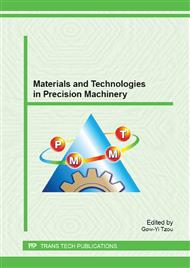[1]
S. Kalpakjian, S. Schmid, Manufacturing Engineering and Technology, sixth ed., Prentice Hall, New York, (2010).
Google Scholar
[2]
D. Dimtrov, W. van Wijck, K. Schreve, N. de Beer, Investigating the achievable accuracy of three dimensional printing, Rapid Prototyping Journal, 12/1 (2006) 42-52.
DOI: 10.1108/13552540610637264
Google Scholar
[3]
C.K. Chua, K.F. Leong, 3D printing and additive manufacturing, fourth ed., World Scientific Publishing, Singapore, (2015).
Google Scholar
[4]
M. Mahesh, Y.S. Wong, J.Y.H. Fuh, H.T. Loh, Benchmarking for comparative evaluation of RP systems and processes, Rapid Prototyping Journal, 10/2 (2004) 123-135.
DOI: 10.1108/13552540410526999
Google Scholar
[5]
T. Brajlih, B. Valentan, J. Balic, I. Drstvensek, Speed and accuracy evaluation of additive manufacturing machines, Rapid Prototyping Journal, 17/1 (2011) 64-75.
DOI: 10.1108/13552541111098644
Google Scholar
[6]
D.N. Silva, M. Gerhardt De Oliveira, E. Meurer, M.I. Meurer, J.V. Lopes Da Silva, A. Santa-Barbara, Dimensional error in selective laser sintering and 3D-printing of models for craniomaxillary anatomy reconstruction, Journal of Cranio-Maxillofacial Surgery, 36 (2008).
DOI: 10.1016/j.jcms.2008.04.003
Google Scholar
[7]
A. Farzadi, V. Waran, M. Solati-Hashjin, Z.A.A. Rahman, M. Asadi, N.A.A. Osman, Effect of layer printing delay on the mechanical properties and dimensional accuracy of 3D printed porous prototypes in bone tissue engineering, Ceramics International, http: /dx. doi. org/10. 1016/j. ceramint. 2015. 03. 004.
DOI: 10.1016/j.ceramint.2015.03.004
Google Scholar
[8]
S. Stopp, T. Wolff, F. Irlinger, T. Lueth, A new method for printer calibration and contour accuracy manufacturing with 3D-print technology, Rapid Prototyping Journal, 14/3 (2008) 167-172.
DOI: 10.1108/13552540810878030
Google Scholar
[9]
C. Lynn-Charney, D.W. Rosen, Usage of accuracy models in stereolithography process planning, Rapid Prototyping Journal, 6/2 (2000) 77-86.
DOI: 10.1108/13552540010323600
Google Scholar
[10]
B. Asiabanpour, K. Palmer, B. Khoshnevis, An experimental study of surface quality and dimensional accuracy for selective inhibition of sintering, 10/3 (2004) 181-192.
DOI: 10.1108/13552540410539003
Google Scholar


